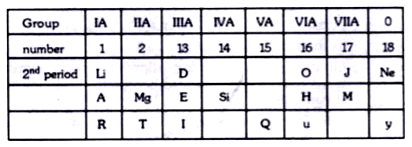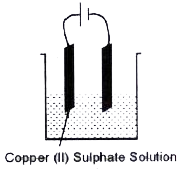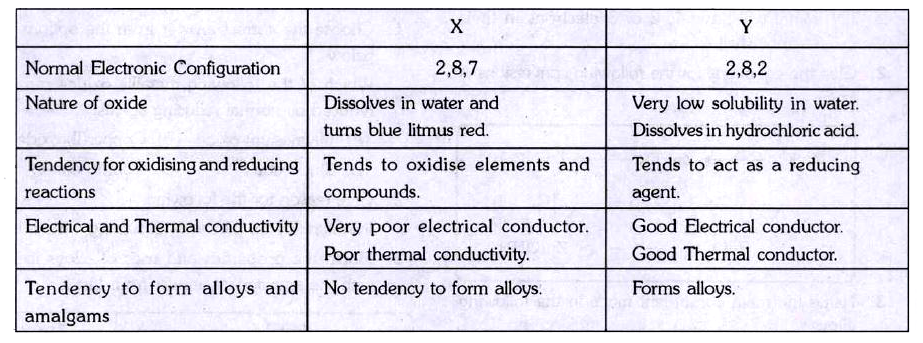Complete Solutions to SECTION-II (40 Marks) of chapter CHEMISTRY-2013 of Class 10 book with complete answers and questions
| Class 10 | CHEMISTRY |
| Chapter | CHEMISTRY-2013 |
| GURUKUL PUBLICATION | SECTION-II (40 Marks) |
| Number Of Questions | 48 |
| Academic Year | 2023-24 |

• In this table H does not represent hydrogen.
• Some elements are given in their own symbol and position in the periodic table.
• While others are shown with a letter.
With reference to the table answer the following questions :
Identify the most electronegative element.
View Solution
In this table H does not represent hydrogen.
Some elements are given in their own symbol and position in the periodic table.
While others are shown with a letter.
With reference to the table answer the question :
Identify the least reactive element of group 1.
View Solution
• In this table H does not represent hydrogen.
• Some elements are given in their own symbol and position in the periodic table.
• While others are shown with a letter.
With reference to the table answer the following questions :
Identify the element from period 3 with least atomic size.
View Solution
• In this table H does not represent hydrogen.
• Some elements are given in their own symbol and position in the periodic table.
• While others are shown with a letter.
With reference to the table answer the following questions :
How many valence electrons are present in Q?
View Solution
• In this table H does not represent hydrogen.
• Some elements are given in their own symbol and position in the periodic table.
• While others are shown with a letter.
With reference to the table answer the following questions :
Which element from group 2 would have the least ionization energy?
View Solution
• In this table H does not represent hydrogen.
• Some elements are given in their own symbol and position in the periodic table.
• While others are shown with a letter.
With reference to the table answer the following questions :
Identify the noble gas of the fourth period.
View Solution
• In this table H does not represent hydrogen.
• Some elements are given in their own symbol and position in the periodic table.
• While others are shown with a letter.
With reference to the table answer the following questions :
In the compound between A and H what type of bond would be formed and give the molecular formula for the same.
View SolutionCompare the compounds methane and sodium chloride with regard to solubility in water and electrical conductivity.
View SolutionChoosing the substances from the list given below, write balanced chemical equations for the reactions which would be used in the laboratory to obtain the following salts:

Sodium sulphate
View SolutionChoosing the substances from the list given below, write balanced chemical equations for the reactions which would be used in the laboratory to obtain the following salts:

Zinc carbonate
View SolutionChoosing the substances from the list given below, write balanced chemical equations for the reactions which would be used in the laboratory to obtain the following salts:

Copper(II) sulphate
View SolutionWrite balanced chemical equations for the reactions which would be used in the laboratory to obtain Iron(II) sulphate.
View SolutionState two relevant observation
Ammonium hydroxide solution is added to copper (II) nitrate solution in small quantities and then in excess.
View SolutionState two relevant observation
Ammonium hydroxide solution is added to zinc nitrate solution in minimum quantities and then in excess.
View SolutionState two relevant observation
Lead nitrate crystals are heated in a hard glass test tube.
View SolutionCopper sulphate solution is electrolysed using copper electrodes. Study the diagram given below and answer the question that follows: Which electrode to your left or right is known as the oxidising electrode and why?

View SolutionCopper sulphate solution is electrolysed using copper electrodes. Study the diagram given below and answer the question that follows: Which electrode to your left or right is known as the oxidising electrode and why?

View SolutionCopper sulphate solution is electrolysed using copper electrodes. Study the diagram given below and answer the question that follows:

Write the equation representing the reaction that occurs.
View Solution
Using the information above, complete the following:
.......... is the metallic element.
View Solution
Using the information above, complete the following:
Metal atoms tend to have a maximum of ...... electrons in the outermost energy level.
View Solution
Using the information above, complete the following:
Non-metallic elements tend to form .......... oxides while metals tend to form ...... oxides.
View Solution
Using the information above, complete the following:
Non-metallic elements tend to be ...... conductors of heat and electricity.
View Solution
Using the information above, complete the following:
Metals tend to .......... electrons and act as ..... agents in their reactions with elements and compounds.
View SolutionGive balanced equations for
Reduction of hot copper (II) oxide to copper using ammonia gas.
View SolutionGive balanced equations for
Oxidation of carbon with concentrated nitric acid.
View SolutionGive balanced equations for
Dehydration of concentrated sulphuric acid with sugar crystals.
View SolutionCopy and complete the following table relating to important industrial process:

View SolutionThe following questions relate to the extraction of aluminium by electrolysis :
Name the other aluminium containing compound added to alumina and state its significance.
View SolutionThe following questions relate to the extraction of aluminium by electrolysis :
Give the equation for the reaction that takes place at the cathode.
View SolutionThe following questions relate to the extraction of aluminium by electrolysis :
Explain why is it necessary to renew the anode periodically.
View SolutionGive balanced chemical equation for the preparation of the following organic compounds.
A saturated hydrocarbon from iodomethane
View SolutionGive balanced equations for the laboratory preparations of butene from butanol
View SolutionGive balanced equations for the laboratory preparations of the organic compounds :
An unsaturated hydrocarbon from calcium carbide.
View SolutionGive balanced equations for the laboratory preparations of.
i] A saturated hydrocarbon from iodomethane.
ii] An unsaturated hydrocarbon from an alcohol.
iii] An unsaturated hydrocarbon from calcium carbide.
iv] An alcohol from ethyl bromide.
View SolutionGive the structural formula of each of the isomer of butane
View SolutionGive the structural formulae for the following
An isomer of n-butane.
(ii) 2-propanol.
(iii) Diethyl ether.
View SolutionDraw the structural formula for the diethyl ether
View SolutionGive reasons for
Methane does not undergo addition reactions, but ethene does.
View SolutionGive reasons for the following :
(i) Methane does not undergo addition reactions, but ethene does.
(ii) Ethyne is more reactive than ethane.
(iii) Hydrocarbons are excellent fuels.
View SolutionGive reasons why?
Hydrocarbons are excellent fuels.
View Solution`O_(2)` is evolved by heating `KClO_(3)` using `MnO_(2)` as a catalyst
`2KClO_(3) overset(MnO_(2))to 2KCl+3O_(2)`
Calculate the mass of `KClO_(3)` required to produce 6.72 litre of `O_(2)` at S.T.P. [atomic masses of K = 39, Cl = 35.5, O = 16).
View Solution`O_(2)` is evolved by heating `KClO_(3)` using `MnO_(2)` as a catalyst
`2KClO_(3) overset(MnO_(2))to 2KCl+3O_(2)`
Calculate the number of moles of oxygen produced in the above reaction if 56g of `KClO_(3)` is used.
View Solution`O_(2)` is evolved by heating `KClO_(3)` using `MnO_(2)` as a catalyst
`2KClO_(3) overset(MnO_(2))to 2KCl+3O_(2)`
Calculate the mass of `KClO_(3)` required to produce 6.72 litre of `O_(2)` at S.T.P. [atomic masses of K = 39, Cl = 35.5, O = 16).
View SolutionIdentify the following substance which is underlined: An alkaline gas which produces dense white fumes when reacted with hydrogen chloride gas.
View SolutionIdentify the following substance which is underlined: An acid which is present in vinegar.
View SolutionIdentify the following substance :
A gas which does not conduct electricity in the liquid state but conducts electricity when dissolved in water.
View SolutionIdentify the following substance : A dilute mineral acid which forms a white precipitate of barium sulphate when treated with barium chloride solution.
View SolutionIdentify: The element which has the highest ionization potential.
View Solution
SECTION-II (40 Marks) questions and complete solutions for chapter CHEMISTRY-2013 of EVERGREEN CHEMISTRY (ENGLISH) of Class 10